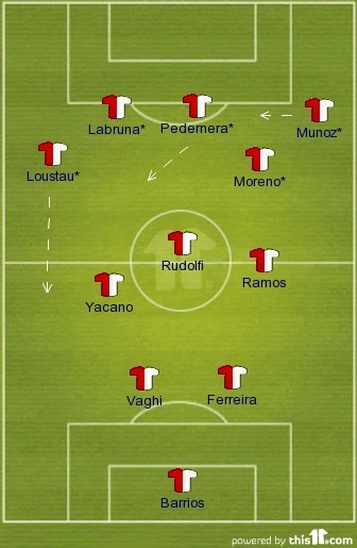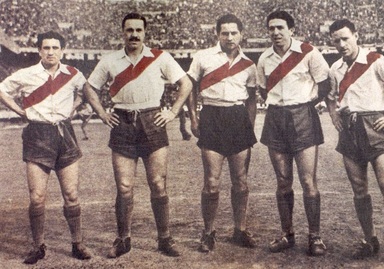River Plate 1941-47

Classic 'La Maquina' lineup
Coach: Jose Maria Minella
Achievements: Argentinian League 1941, 42, 45, 47
Key Players: Pedernera, Labruna, Moreno Loustau, Munoz, Vaghi
Formation: 2-3-5
While Europe was at war this Argentinian team, between 1941 and 1947, won four domestic titles, finished second twice, and played beautiful football. Featuring a famed forward line known as 'La Maquina' (The Machine) they swept all before them, playing a prototype 'Total Football' thirty years ahead of their time. Perhaps the greatest praise for La Maquina came from one of its biggest archrivals. Ernesto Lazatti, the Boca Juniors star from the 1940's had this to say: "I play against La Maquina with the full intention of beating them, but as a fan of football, I would prefer to sit on the stands and watch them play"
The famed 'La Maquina' forward line began in June of 1941 when Adolfo Pedernera replaced Roberto D'Allessandro at centre-forward and ended with Pedernera's retirement in November of 1946 (his replacement was a young Alfredo Di Stefano). Athough La Maquina is best remembered for the memorable forward line of Munoz, Moreno, Pedernera, Labruna and Lostau, these five players only played 18 league matches together, with 'Mono' Deambrossi and Alberto Gallo also alternating with them on the attack. The biggest attribute of 'La Maquina' was its dynamism. The five forwards were all very talented and (by the standards of the day) had great physical stamina. They did not have fixed positions and constantly rotated, which is why the team is considered a precursor of the Dutch system of the 1970's.
With its most common lineup (see above) the team had a solid defense, with a genuine defensive rock, the temperamental Ricardo Vaghin acting as the anchor. In midfield, it boasted two defensive midfielders of great sacrifice and vision in Bruno Rodolfi and Jose Ramos. They were joined in midfield by 'Charro' Moreno, the creative force of the team, who tracked back and covered the whole right side. Adolfo Pedernera, the centre-forward, would withdraw to midfield, confounding the central defenders who were supposed to mark him and opening spaces for the other forwards (as Hidegkuti would do for Hungary in the following decade). The talented and opportunistic Angel Labruna took full advantage of this space, enabling him to become one of the most prolific goalscorers in the history of Argentine football. Labruna was complemented by the two wide wings, Juan Carlos Munoz and Felix Lostau. And of course, Moreno and Pedernera were also lethal joining the attack from midfield.
In the 1950's a number of Argentine players left the country, including the likes of Di Stefano, Sivori, Maschio and Angelillo, who did extremely well in Europe and are considered all-time greats. But old-time Argentine football fans (and indeed Di Stafnao himself) would argue that these players from the 1940's were even better than those from the 1950's who found success in Europe. However, since Europe was at war and there were practically no international tournaments or matches at the time (Argentina chose not to compete in the 1950 World Cup), the players didn't get the same international exposure, so this is a premise that's impossible to prove.
Further reading (with thanks): http://www.bigsoccer.com/forum/blog.php?b=2880
Achievements: Argentinian League 1941, 42, 45, 47
Key Players: Pedernera, Labruna, Moreno Loustau, Munoz, Vaghi
Formation: 2-3-5
While Europe was at war this Argentinian team, between 1941 and 1947, won four domestic titles, finished second twice, and played beautiful football. Featuring a famed forward line known as 'La Maquina' (The Machine) they swept all before them, playing a prototype 'Total Football' thirty years ahead of their time. Perhaps the greatest praise for La Maquina came from one of its biggest archrivals. Ernesto Lazatti, the Boca Juniors star from the 1940's had this to say: "I play against La Maquina with the full intention of beating them, but as a fan of football, I would prefer to sit on the stands and watch them play"
The famed 'La Maquina' forward line began in June of 1941 when Adolfo Pedernera replaced Roberto D'Allessandro at centre-forward and ended with Pedernera's retirement in November of 1946 (his replacement was a young Alfredo Di Stefano). Athough La Maquina is best remembered for the memorable forward line of Munoz, Moreno, Pedernera, Labruna and Lostau, these five players only played 18 league matches together, with 'Mono' Deambrossi and Alberto Gallo also alternating with them on the attack. The biggest attribute of 'La Maquina' was its dynamism. The five forwards were all very talented and (by the standards of the day) had great physical stamina. They did not have fixed positions and constantly rotated, which is why the team is considered a precursor of the Dutch system of the 1970's.
With its most common lineup (see above) the team had a solid defense, with a genuine defensive rock, the temperamental Ricardo Vaghin acting as the anchor. In midfield, it boasted two defensive midfielders of great sacrifice and vision in Bruno Rodolfi and Jose Ramos. They were joined in midfield by 'Charro' Moreno, the creative force of the team, who tracked back and covered the whole right side. Adolfo Pedernera, the centre-forward, would withdraw to midfield, confounding the central defenders who were supposed to mark him and opening spaces for the other forwards (as Hidegkuti would do for Hungary in the following decade). The talented and opportunistic Angel Labruna took full advantage of this space, enabling him to become one of the most prolific goalscorers in the history of Argentine football. Labruna was complemented by the two wide wings, Juan Carlos Munoz and Felix Lostau. And of course, Moreno and Pedernera were also lethal joining the attack from midfield.
In the 1950's a number of Argentine players left the country, including the likes of Di Stefano, Sivori, Maschio and Angelillo, who did extremely well in Europe and are considered all-time greats. But old-time Argentine football fans (and indeed Di Stafnao himself) would argue that these players from the 1940's were even better than those from the 1950's who found success in Europe. However, since Europe was at war and there were practically no international tournaments or matches at the time (Argentina chose not to compete in the 1950 World Cup), the players didn't get the same international exposure, so this is a premise that's impossible to prove.
Further reading (with thanks): http://www.bigsoccer.com/forum/blog.php?b=2880
|
|

